#nasa artemis 1 rocket launch scrubbed
Text
নাসার মুন রকেটের দ্বিতীয় উৎক্ষেপণের উদ্যোগ বাতিল
নাসার মুন রকেটের দ্বিতীয় উৎক্ষেপণের উদ্যোগ বাতিল
নাসার নতুন আর্টেমিস আই মুন রকেটের উৎক্ষেপণ স্থগিত হওয়ার পর সম্ভাব্য দীর্ঘ বিলম্বের সম্মুখীন হচ্ছে। এটি হলো, নাসার মুন রকেটের দ্বিতীয় উৎক্ষেপণের উদ্যোগ বাতিল।
স্পেস লঞ্চ সিস্টেম (SLS) যানটি উঠানোর জন্য কন্ট্রোলাররা শনিবার আবার চেষ্টা করে ব্যর্থ হয়েছেন। কিন্তু জ্বালানি লিক বন্ধ করতে পারেনি।
প্রকৌশলীদের এখন রকেটটি পরিদর্শন করতে হবে। যেকোন সম্ভাব্য মেরামত লঞ্চ প্যাডের পরিবর্তে ওয়ার্কশপে…
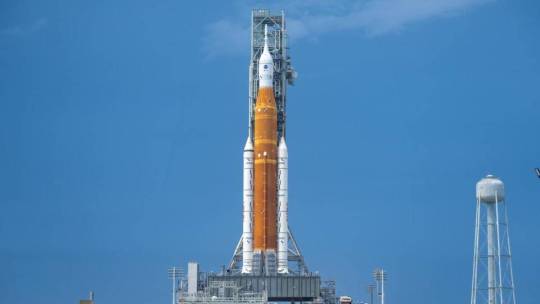
View On WordPress
#artemis#artemis 1#artemis 1 launch#artemis 1 mission#artemis 1 rocket launch#artemis 1 rocket launch florida#artemis 1 rocket launch scrubbed#artemis launch#artemis launch 2022#moon rocket#nasa artemis 1 rocket launch#nasa artemis 1 rocket launch scrubbed#nasa artemis launch#nasa moon mission#nasa moon rocket artemis 1 launch#nasa moon rocket launch#nasa moon rocket launch date#nasa rocket launch#rocket launch#space launch system
2 notes
·
View notes
Text
youtube
If you missed the launch here’s my video of it
#Nasa#nasa#astronomy#Space#space#video#artemis mission#artemis launch#artemis 1 launch#Artemis 1 news#artemis 1 live — historic nasa launch scrubbed after rocket problems after thousands of fans waited to watch takeoff#Youtube
3 notes
·
View notes
Text
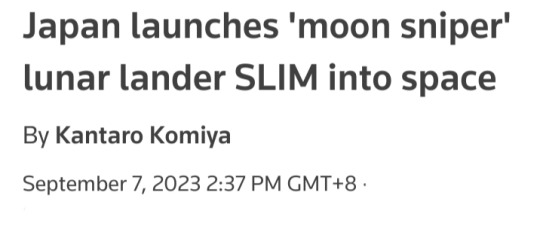

TOKYO, Sept 7 (Reuters) - Japan launched its lunar exploration spacecraft on Thursday aboard a homegrown H-IIA rocket, hoping to become the world's fifth country to land on the moon early next year.
Japan Aerospace Exploration Agency (JAXA) said the rocket took off from Tanegashima Space Center in southern Japan as planned and successfully released the Smart Lander for Investigating Moon (SLIM).
Unfavourable weather led to three postponements in a week last month.
Dubbed the "moon sniper," Japan aims to land SLIM within 100 metres of its target site on the lunar surface.
The $100-million mission is expected to start the landing by February after a long, fuel-efficient approach trajectory.
"The big objective of SLIM is to prove the high-accuracy landing ... to achieve 'landing where we want' on the lunar surface, rather than 'landing where we can'," JAXA President Hiroshi Yamakawa told a news conference.

The launch comes two weeks after India became the fourth nation to successfully land a spacecraft on the moon with its Chandrayaan-3 mission to the unexplored lunar south pole.
Around the same time, Russia's Luna-25 lander crashed while approaching the moon.
Two earlier lunar landing attempts by Japan failed in the last year.
JAXA lost contact with the OMOTENASHI lander and scrubbed an attempted landing in November.
The Hakuto-R Mission 1 lander, made by Japanese startup ispace (9348.T), crashed in April as it attempted to descend to the lunar surface.
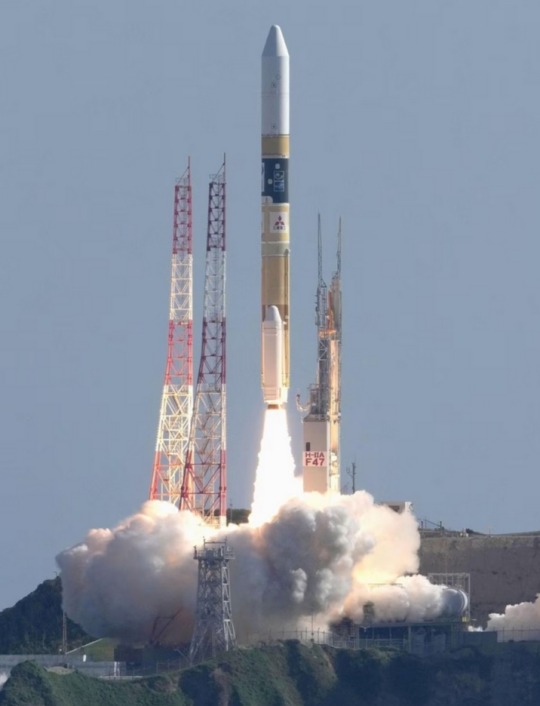
SLIM is set to touch down on the near side of the moon close to Mare Nectaris, a lunar sea that, viewed from Earth, appears as a dark spot.
Its primary goal is to test advanced optical and image processing technology.
After landing, the craft aims to analyse the composition of olivine rocks near the sites in search of clues about the origin of the moon. No lunar rover is loaded on SLIM.
Thursday's H-IIA rocket also carried the X-Ray Imaging and Spectroscopy Mission (XRISM) satellite, a joint project of JAXA, NASA and the European Space Agency.
The satellite aims to observe plasma winds flowing through the universe that scientists see as key to helping understand the evolution of stars and galaxies.

Mitsubishi Heavy Industries (7011.T) manufactured the rocket and operated the launch, which marked the 47th H-IIA rocket Japan has launched since 2001, bringing the vehicle's success rate close to 98%.
JAXA had suspended the launch of H-IIA carrying SLIM for several months while it investigated the failure of its new medium-lift H3 rocket during its debut in March.
Japan's space missions have faced other recent setbacks, with the launch failure of the Epsilon small rocket in October 2022, followed by an engine explosion during a test in July.
The country aims to send an astronaut to the moon's surface in the latter half of the 2020s as part of NASA's Artemis programme.
https://www.reuters.com/technology/space/japan-launches-rocket-carrying-moon-lander-slim-after-three-delays-2023-09-06/
youtube
Japan launches 'Moon Sniper' mission | AFP
7 September 2023
Japan's "Moon Sniper" mission blasted off Thursday as the country's space programme looks to bounce back from a string of recent mishaps, weeks after India's historic lunar triumph.
#H-IIA rocket#Japan#lunar exploration spacecraft#SLIM#moon sniper#Japan Aerospace Exploration Agency (JAXA)#Tanegashima Space Center#Smart Lander for Investigating Moon#Hiroshi Yamakawa#Hakuto-R Mission 1 lander#ispace#Mare Nectaris#X-Ray Imaging and Spectroscopy Mission (XRISM) satellite#JAXA#NASA#European Space Agency#Mitsubishi Heavy Industries#Artemis#space#space rocket#Youtube#Chandrayaan-3 mission#Luna-25 lander#India#Russia#moon#moon landing
22 notes
·
View notes
Text
Artemis I: Launch Viewing Guide

@nasa is planning to launch its new Space Launch System (SLS) rocket on its maiden voyage later this week. The uncrewed Artemis I mission will be the first integrated test of NASA’s new deep space exploration systems, designed to return humanity to the Moon and, eventually, explore Mars. Currently targeting Wednesday, November 16, at 1:04 AM ET (0604 UTC), with a two-hour window from Kennedy Space Center’s Launch Complex 39B (LC-39B), the mission is anticipated to bring hundreds of thousands of spectators into the area with hopes of witnessing history. With paid viewing options selling out near-instantaneously and large crowds flocking to the area, many launchgoers are scrambling to find the best spots to watch the historic launch.
As a lifelong space nerd, former spaceflight media, and current NASA Launch Control Operator, I’ve seen launches from practically every viewing location on the Space Coast, from our gorgeous beaches to the rooftop of the Vehicle Assembly Building (VAB). In this guide, I will provide my recommended viewing locations for launch and give some pro tips to help ensure you have an unforgettable viewing experience.
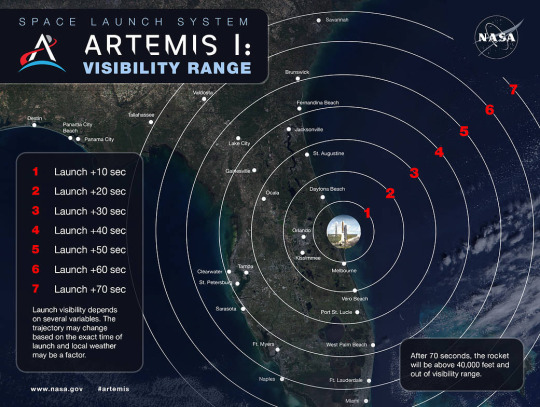
Scrubs Happen!
After previous scrubs and launch delays, I wanted to include this little section to help manage the expectations of first-time launchgoers. Scrubs and delays happen, more so with the first launch of a new vehicle. Keep in mind that a million things must go right for liftoff, and only one needs to go wrong for a scrub. While scrubs are disappointing, operators will always prioritize safety and mission assurance. As history has shown time and time again, “go fever” leads to disaster. As many veteran launchgoers will tell you, scrubs are part of the business. Always plan for a launch as if it were going to scrub. Include extra days to account for delays. If we happen to scrub on Wednesday (knock on wood), here are our backup dates:
Saturday, November 19, at 1:45 AM ET (0645 UTC)
Friday, November 25, at 10:10 AM ET (1510 UTC)
Pay attention to the NASA broadcast and local officials for the latest updates on the status of the launch.

Safety First!
As exciting as rocket launches are, please don’t do anything that would jeopardize your safety or the safety of others. NOTAMs, NOTMARs, launch hazard areas, and exclusion zones will be issued by the FAA, Coast Guard, Space Force, NASA, and local authorities in the days leading to the launch. Violating these can result in legal prosecution, heavy fines, and even delay the launch. It is best for everyone to follow the direction of local officials.
Pack Enough Supplies and Charge Up!
Bring enough bug spray, food, and water to last the entire day. Be sure to fully charge your devices and bring a power bank or two. Keep in mind that cellular coverage will be spotty due to the influx of traffic on launch day, so plan accordingly.
COVID-19
As much as we all hate hearing it, the pandemic hasn’t disappeared, and Brevard County is still considered a high transmission community — even without the large crowds. Please do your best to maintain social distancing. Make sure you are up-to-date with your vaccines and wear a mask if you are indoors. Most importantly, stay home if you are sick or have been exposed to/tested positive for Coronavirus. Don’t risk the health of others just to get a closer view of the launch. Be responsible.
Traffic, Traffic, Traffic!
Due to the high number of spectators traveling to the area for the launch, officials will enforce special traffic flows on launch day. Please drive carefully, remain vigilant, and follow the directions of local authorities. Yield to pedestrians, be patient, and drive defensively. Be sure to look over the traffic flow map below before heading out to your chosen viewing area!

Paid Viewing Options
While there are many fantastic areas to view for free, paid options offer amenities and stability that public viewing simply can’t. That said, this does not mean that paid locations are always better for the view. Public areas often offer a comparable, sometimes even better, view than their paid counterparts. I only recommend paid viewing to families, those physically unable to camp roadside for hours with limited amenities, or those interested in a more exclusive viewing experience. Most paid viewing options have sold out, and thus been removed from the list. Of those still available, here are my recommended paid viewing locations:
Airbnb, Vrbo, etc.
Another option for private launch viewing with maximum comfort is renting a house/room via Airbnb, Vrbo, etc. Prices and locations vary widely, though I recommend looking for rentals along the Indian River.
NOTE: Be weary of resale scams and scalpers. KSCVC does NOT allow the resale or transfer of purchased viewing packages.

Free Viewing Options
The Space Coast is known for its beautiful beaches and parks, all of which are excellent areas to view from! Free viewing options can often offer better views than paid viewing. However, they do require a bit more planning.
When to Arrive
You will need to get to your planned location EARLY! The most determined launch enthusiasts will be camping at their spots for 8-10 hours. Unless you are a photographer needing the absolute best spot your site has to offer, you do not need to do that. I recommend arriving around 3-4 hours prior to launch for the best chance at viewing from your chosen location.
Clean Before You Leave
When viewing at any location, please clean up after yourself! Leave the area better than you found it. Help keep our beaches and parks safe and beautiful.
Public Viewing Areas
Some of the best public viewing areas available are located just west of KSC along the Indian River. Many of these locations offer an unobstructed view of launch. However, because of this, you can expect the majority of the traffic to be centered there. If you don’t mind viewing a bit farther away, or don’t need an unobstructed view of the pad, there are plenty of areas to the south that offer decent viewing and may escape the worst of the traffic.
You can view it practically everywhere in the area. This is one of the largest, most powerful rockets ever launched. Trust me, you’ll see it no matter where you are. However, if you want the best possible viewing spots, here are my recommendations:
Max Brewer Bridge / Parrish Park
Distance: 10 miles (16 km)
Amenities: Bathrooms
Parking: Extremely limited
Space View Park
Distance: 11 miles (18 km)
Amenities: Bathrooms
Parking: Extremely limited
Sand Point Park
Distance: 11 miles (18 km)
Amenities: Bathrooms, Pavillions
Parking: Extremely limited
Marina Park
Distance: 11 miles (18 km)
Amenities: Bathrooms, Pavillions
Parking: Extremely limited
William J. Manzo Memorial Park
Distance: 12 miles (19 km)
Amenities: Bathrooms, Pavillions, Electric Outlets
Parking: Extremely limited
Rotary Riverfront Park
Distance: 12 miles (19 km)
Amenities: Pavillions
Parking: Extremely limited
Chain of Lakes Park
Distance: 13 miles (19 km)
Amenities: Bathrooms, Pavillions, Observation Tower
Parking: Limited
Cherie Down Park
Distance: 16 miles (26 km)
Amenities: Bathrooms, Pavillions
Parking: Extremely Limited
Cocoa Beach Pier
Distance: 18 miles (29 km)
Amenities: Bathrooms, Pavillions, Restaurants
Parking: Available
NOTE: Playalinda Beach will be CLOSED for launch due to its close proximity to LC-39B and the launch window opening outside of its normal operating hours. Max Brewer Bridge will likely only allow foot traffic on Tuesday night/Wednesday morning. SOME OF THESE LOCATIONS MAY HAVE BEEN SEVERELY IMPACTED BY HURRICANE NICOLE.

Remote Viewing Options
Can’t make it over for launch or simply want to enjoy from the comfort of your home? No worries! Here’s where you can watch, listen, and follow along with the launch of Artemis I!
NASA TV
NASA will be streaming live coverage on NASA TV and NASA social media. A clean feed will be carried on the NASA TV media channel featuring views of the rocket and audio from a commentator in the Launch Control Center (LCC) throughout. Countdown net will be begin streaming publicly at T-15 minutes.
Content Creators and Online Streams
There will be plenty of content creators and spaceflight media outlets hosting their own streams of the launch as well! Check in with your favorite creators to see when their coverage begins.
NOTE: Be weary of clicking links posted to social media. Double-check to ensure the poster is a trusted source BEFORE clicking. Be on the lookout for phishing attacks and malicious links, which tend to increase during large events like this.
Radio
The best option for those viewing the launch in-person. Get live launch updates while circumventing the area’s overburdened cellular coverage! Coverage will be broadcast on local amateur VHF radio frequency 146.940 MHz and UHF radio frequency 444.925 MHz, FM mode. Only availble to those in the Brevard County area.
Dial-In
The second best option for those viewing in-person. Want live updates but don’t have a radio or enough signal to stream a video? No worries! Full audio from the launch broadcast will be carried on 321–867–1220, -1240, -1260 or –7135., -1240, -1260 or –7135.

We Are Going
As someone lucky enough to play a small role in this incredible program, thank you for sharing your excitement and coming out to witness this historic launch. We are going because of individuals like you, those who look up and see not an empty void but a vast sea of stars beckoning our exploration. Launches, especially ones of this magnitude, ignite the curiosity and imaginations of people far and wide. It was in the final years of the Shuttle Program that my passion was realized. I hope that, with Artemis, the next generation will hear their calling too. Through Artemis, we are going to push further than ever before and test the true might of human adaptability and ingenuity. We. Are. Going.
#nasa#artemis#space launch system#space#spaceflight#science#engineering#travel guide#spacecraft#outer space
10 notes
·
View notes
Text
Hydrogen leak causes 2nd scrub for Artemis 1
Hydrogen leak causes 2nd scrub for Artemis 1
The Artemis 1 SLS rocket will remain on the ground a little longer as a hydrogen leak caused launch teams to call off today’s attempt. Credit: Theresa Cross / Spaceflight Insider
After hours of troubleshooting a hydrogen leak, NASA called off its second attempt to get the Artemis 1 Space Launch System rocket off the ground. (more…)
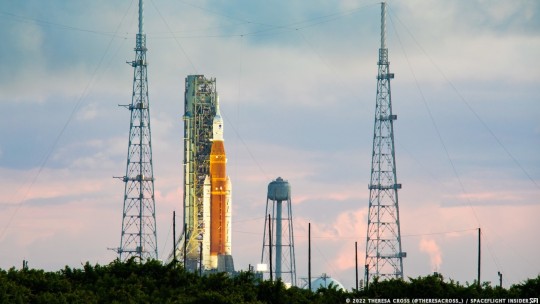
View On WordPress
2 notes
·
View notes
Text
NASA Blazes a Path Back to the Moon With Artemis I Rocket Launch
https://sciencespies.com/news/nasa-blazes-a-path-back-to-the-moon-with-artemis-i-rocket-launch/
NASA Blazes a Path Back to the Moon With Artemis I Rocket Launch
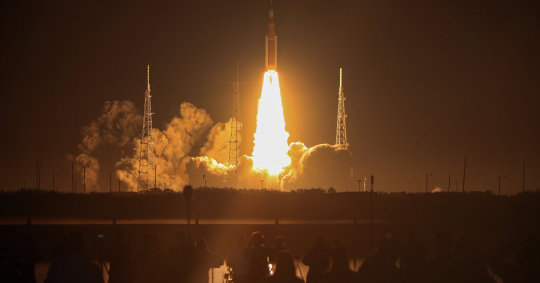
KENNEDY SPACE CENTER, Fla. — NASA’s majestic new rocket soared into space for the first time in the early hours of Wednesday, lighting up the night sky and accelerating on a journey that will take an astronaut-less capsule around the moon and back.
This flight, evoking the bygone Apollo era, is a crucial test for NASA’s Artemis program that aims to put astronauts, after five decades of loitering in low-Earth orbit, back on the moon.
“We are all part of something incredibly special,” Charlie Blackwell-Thompson, the launch director, said to her team at the Kennedy Space Center after the launch. “The first launch of Artemis. The first step in returning our country to the moon and on to Mars.”
For NASA, the mission ushers in a new era of lunar exploration, one that seeks to unravel scientific mysteries in the shadows of craters in the polar regions, test technologies for dreamed-of journeys to Mars and spur private enterprise to chase new entrepreneurial frontiers farther out in the solar system.
As China and other countries are vying to explore space, Wednesday’s launch also highlights a growing philosophical tension about how America should pursue its space aspirations. NASA has spent more than $40 billion to date to get Artemis off the ground. The expenditure illustrates how the space program continues to resemble the way that the Pentagon builds aircraft carriers and F-35 fighters — expensive and slow, but primarily controlled by the federal government because no commercial market yet exists for the kinds of large rockets and deep-space transports that NASA considers to be necessary for its moon exploration program.
At 1:47 a.m., the four engines on the rocket’s core stage along with two side boosters ignited and Artemis lifted from Earth. “I’m telling you we’d never seen such a tail of flame,” said Bill Nelson, the NASA administrator.Keegan Barber/NASA
The alternative approach, where NASA would be a customer or a passenger on commercial spacecraft, could be cheaper and faster, relying on innovative spacecraft built by entrepreneurial companies like SpaceX, led by Elon Musk.
“If you were serious about going back to the moon, you would just go all-in on commercial approaches,” said Charles Miller, who worked at NASA from 2009 to 2012 as a senior adviser for commercial space activities.
But the commercial approach might not exactly provide what NASA and other government decision makers want, and companies can often change plans or go out of business.
In the geopolitical background for policymakers is a growing competition with China, the only country that now has robotic spacecraft on the lunar surface. China last month completed construction of its own space station, and the country’s space officials aim to construct a research outpost on the moon and send astronauts there in the 2030s.
Bill Nelson, the NASA administrator, has warned that China could become the dominant lunar superpower, concerns that echo the jostling between the United States and the Soviet Union in the 1960s that motivated the Apollo moon landings between 1969 and 1972.
Orion’s view of Earth, at a distance of about 50,000 miles, on its trip to the moon on Wednesday.NASA
While it may not have mollified the critics, the 322-foot-tall rocket, known as the Space Launch System, or S.L.S., was an imposing sight on the launchpad. However, with the middle-of-the-night launch time, the Florida Space Coast was not as jammed with spectators as it had been for earlier launch attempts.
Wednesday’s launch attempt followed two scrubbed launch attempts in August and September, one halted by an engine that appeared to be too warm, and the other involving a hydrogen leak in a fuel line. Hurricane Ian led NASA to skip another launch window in late September and early October, and Hurricane Nicole prompted a delay by a couple of days before Wednesday’s launch.
The countdown proceeded smoothly until a hydrogen leak in a new location popped up at about 9:15 p.m. A “red crew” of two technicians and a safety officer went to the launchpad to tighten bolts on a valve, which stemmed the leak.
A faulty Ethernet switch also disrupted the countdown, cutting off data from a radar needed to track the rocket. The U.S. Space Force, which ensures safety of rocket launches from the Kennedy Space Center, replaced the equipment, and the countdown resumed.
A final poll by Ms. Blackwell-Thompson confirmed the rocket was ready to go to space.
At 1:47 a.m., the four engines on the rocket’s core stage ignited, along with two skinnier side boosters. As the countdown hit zero, clamps holding the rocket down let go, and the vehicle slipped Earth’s bonds.
Charlie Blackwell-Thompson, Artemis’s launch director, during a briefing on Saturday.Kim Shiflett/NASA
At liftoff, flames from the engines were incredibly bright, like giant welding torches.
“I’m telling you we’d never seen such a tail of flame,” Mr. Nelson said.
As the rocket ascended, it produced a loud rumble of sound that rolled across the space center.
A few minutes later, the side boosters and then the giant core stage separated. The rocket’s upper engine then ignited to carry the Orion spacecraft, where astronauts will sit during later missions, toward orbit.
Less than two hours after launch, the upper stage fired one last time to send Orion on a path toward the moon. On Monday, Orion will pass within about 60 miles of the moon’s surface. After going around the moon for a couple of weeks, Orion will head back to Earth, splashing down on Dec. 11 in the Pacific Ocean, about 60 miles off the coast of California.
“We’ve laid the foundation for the Artemis program and many generations to come,” said John Honeycutt, the program manager for the Space Launch System rocket, in a news conference after the launch on Wednesday.
The next Artemis mission, which is to take four astronauts on a journey around the moon but not to the surface, will launch no earlier than 2024. Artemis III, in which two astronauts will land near the moon’s south pole, is currently scheduled for 2025, though that date is very likely to slip further into the future.
The Orion capsule for the Artemis III mission at the Kennedy Space Center. The mission is currently scheduled for 2025, although it is almost certain to be postponed.Chandan Khanna/Agence France-Presse — Getty Images
In a report last year, the NASA inspector general estimated that by the time that Artemis III had returned from the moon, NASA would have spent $93 billion on the program and that each launch of the Space Launch System and Orion would cost more than $4 billion. The cost overruns were caused in part by technical problems, mismanagement and NASA’s changing plans and schedules. And like the old Saturn V, the pricey Space Launch System rocket is used just once before falling into the ocean.
By streamlining the manufacturing, “We’re hoping to get it to a cost of about $2 billion,” per launch, Sharon Cobb, the associate program manager at NASA for the Space Launch System, said during an interview in August.
By contrast, SpaceX’s Falcon Heavy rocket, while not as powerful as S.L.S., costs $90 million per launch. And SpaceX’s Starship, a giant next-generation rocket currently under development that is also central to NASA’s astronaut moon landing plans, is to be entirely reusable, and Mr. Musk has said, perhaps over-optimistically, a launch could eventually cost as little as $10 million.
For Artemis, NASA has taken a mix-and-match approach — a traditional program for the rocket and the crew capsule, and a commercial strategy for the lunar lander. NASA is purchasing from SpaceX, at a fixed price, a flight of Starship to serve as the lander for the Artemis III mission later in the decade. The Starship is to dock with Orion in orbit around the moon and take two astronauts to the surface near the lunar south pole.
An artist’s concept of Starship arriving at a moon base.SpaceX
The delays and cost overruns of S.L.S. and Orion highlight the shortcomings of how NASA has managed its programs, but Mr. Musk’s company, for all of the impressive technological leaps it has made so far, is also not guaranteed to solve all the development challenges of Starship as quickly as Mr. Musk might hope.
His company has been fantastically successful with its Falcon 9 rocket, following on NASA’s investment to take cargo and later astronauts to and from the International Space Station. The cargo contract provided a key infusion of money to Mr. Musk’s company, and bestowed NASA’s imprimatur of approval when SpaceX was still little known and largely unproven. It now dominates the satellite-launching business.
For NASA, this was a big win, too. Because NASA is just one of many customers for SpaceX, SpaceX can offer much lower costs.
Those successes, however, do not guarantee that Starship will also succeed. If SpaceX stumbles, NASA’s gamble on the company’s new spacecraft risks leaving the United States wasting its investment while still waiting for a moon lander for Artemis III.
Still, the sprawling expense of Artemis might be the cost of sustaining political support for a space program in a federal democracy, said Casey Dreier, the chief policy adviser for the Planetary Society, a nonprofit that promotes exploration of space. Even if Artemis is not the best or most efficient design, it provides jobs to the employees of NASA and aerospace companies across the country, he said. That provides continuing political support for the moon program.
“Congress has done nothing but add more money to Artemis every single year it’s been in existence,” Mr. Dreier said.
The rocket’s ascent early Wednesday. Congress has directed NASA to launch the S.L.S. at least once a year, and negotiations are underway with the rocket’s manufacturers for up to 20 more launches.Bill Ingalls/NASA
Politicians have so far faced little or no public outcry when voting to finance the Artemis missions. Even if it saved NASA money, the commercial approach could provoke greater opposition, feeding a perception that the agency has outsourced its space program to billionaires like Mr. Musk; Jeff Bezos, the founder of Amazon who started the rocket company Blue Origin; and Richard Branson, whose Virgin Galactic flies tourists on short suborbital flights.
Consider the ire of many people toward Mr. Bezos and Mr. Branson last year when they made suborbital trips to space built by the companies started with their wealth. That Mr. Branson and Mr. Bezos did not rely on federal financing to start their space tourism businesses did not assuage the anger that space seemed to be turning into the playground of the superwealthy.
Thus, a decision to turn to companies like SpaceX and Blue Origin could set off criticism that NASA was just adding to the wealth of billionaires who would one day escape from worldly troubles to private space stations and off-world colonies.
“By aligning our space program with very famous, idiosyncratic individuals, that could potentially be the bigger political risk, to me,” Mr. Dreier said.
Commercial space advocates argue that history does not back up this dystopian view. Rather, they point to entrepreneurs a century ago who transformed aviation from a luxury available to only a few into safe, affordable transportation for almost everyone.
While private spaceflight proponents believe their approach will prevail, no one in Congress has yet pushed for canceling S.L.S. or Orion. The CHIPS and Science Act, signed into law by President Biden, calls for NASA to include the vehicles in plans to send astronauts to Mars and directs the agency to launch S.L.S. at least once a year.
NASA is currently negotiating with the rocket’s manufacturers for up to 20 more launches.
“I think the program itself is shaping up to be very politically sustainable,” Mr. Dreier said. “I challenge people to show me the public anger about the S.L.S. program and how it translates to political pressure to cancel it. And I just don’t see it.”

How 3 NASA Missions Could Send Astronauts Back to the Moon
By the end of this decade, humans could walk on the moon once again. Here’s how NASA plans to send them there.
#News
0 notes
Text
Attempt No. 3 for Artemis 1, with the promise of a new space age
Attempt No. 3 for Artemis 1, with the promise of a new space age
At 1.04 am Eastern time in the United States on Wednesday (11.34 am in India), a two-hour window will open for NASA to make a third attempt to send its new 322-foot-tall, multi-billion-dollar rocket known as the Space Launch System (SLS), to the Moon.
The debut flight of the rocket was scrubbed twice earlier, on August 29 and September 3, after technical issues were detected during the…

View On WordPress
0 notes
Text
NASAs Megarocket Rolls Again to Launch Pad With Blastoff Simply 10 Days Away
NASA’s House Launch System (SLS) rocket shortly after arriving on the Kennedy launch pad earlier right this moment.
Photograph: NASA/Joel Kowsky
The towering House Launch System is again at Launch Pad 39B at NASA’s Kennedy House Middle in Florida, following a nine-hour trek from the close by Car Meeting Constructing. The company is concentrating on November 14 for the rocket’s first launch, an occasion that may kick off the Artemis 1 mission and NASA’s return to the Moon.
Might this be it? Would possibly this lastly be the final time NASA has to cart the 321-foot-tall (98-meter) SLS rocket to the launch pad? I’m obsessively toggling between optimism and pessimism, as there’s good cause for each.
The launch try on November 14 will likely be NASA’s third attempt at getting the rocket off the bottom, so it’s had loads of apply at this level. However as we noticed throughout these makes an attempt and likewise through the moist gown rehearsals, SLS is a bit finicky, significantly relating to the loading of its liquid hydrogen propellant.
For this mission, an uncrewed Orion spacecraft will journey to the Moon and return to Earth three-and-a-half weeks later, with out performing a lunar touchdown. The aim of the Artemis 1 mission is to check the highly effective new rocket and the Orion capsule, setting the stage for the crewed Artemis 2 mission in 2024.
NASA tried to launch SLS on August 29, however a defective sensor pressured a scrub. The second scrub on September 3 was the results of a hydrogen leak, prompting an impromptu cryogenic tanking check that the company efficiently carried out on September 22. NASA was set to launch the rocket on September 27, however Hurricane Ian despatched SLS again to the Car Meeting Constructing for shelter.
G/O Media could get a fee
Floor groups used the chance to recharge batteries related to the rocket’s flight termination system, the booster, Orion, and batteries belonging to the secondary payload cubesats, Cliff Lanham, senior automobile operations supervisor for NASA’s Exploration Floor Techniques Program, advised reporters Thursday at a press briefing. Some {hardware} was changed and assessments of the flight termination system have been additionally finished, he added, saying no excellent points stay open and that the rocket is able to go.
A storm brewing within the Atlantic has captured the eye of Mark Berger, climate officer of the U.S. House Drive’s forty fifth Climate Squadron. The low strain system, ought to it grow to be one thing larger, would probably have an effect on Kennedy House Middle on the center of subsequent week, he defined through the briefing. That stated, Berger doesn’t count on the winds to pose an issue for SLS, and he’s not significantly involved.
Ought to all go in accordance with plan, the countdown for the third SLS launch try will start simply earlier than 1:00 a.m. ET on November 12, and the rocket would blast off throughout a 69-minute launch window that opens at 12:07 a.m. ET on November 14. On the press briefing, Jim Free, affiliate administrator of NASA’s Exploration Techniques Growth Mission Directorate, stated “everybody’s comfy launching at night time” and that he doesn’t see the darkness “as a barrier to getting the information that we want.”
That’s good, however it’s a disgrace that the rocket gained’t go up throughout sunlight hours, or no less than for this launch try. NASA has to contemplate a big selection of things when figuring out launch home windows, together with the place of Earth, the Moon, and the Solar. Regardless, we gained’t complain once we lastly get to see SLS take flight—one thing that may really occur in simply 10 days.
Extra: NASA’s Artemis Moon Touchdown Program: Launches, Timeline, and Extra
Originally published at Irvine News HQ
0 notes
Text
NASA is now targeting November 14th for the Artemis 1 launch
NASA is now targeting November 14th for the Artemis 1 launch
has for its next launch attempt. The agency will next try to send the Space Launch System (SLS) rocket and Orion spacecraft on an uncrewed journey around the moon on November 14th. The launch window starts at 12:07AM ET and will be open for an hour and nine minutes. In case NASA has to scrub the November 14th launch, it has two backup windows in mind, starting at 1:04AM on November 16 and 1:45AM…
View On WordPress
0 notes
Text
Winter wonders 1.7

#Winter wonders 1.7 crack
'Incredibly rare' SWORDFISH sighting in British waters: 10ft-long fish is spotted leaping out of the water in the Irish Sea in one of only a handful of recorded sightings in the UK NASA's Artemis I mission: How £19 billion Space Launch System rocket will blast off on a 42-day journey around the moon - with Snoopy and Shaun the Sheep on board - paving the way for humans to return to the lunar surface by 2025 One giant step backward! NASA leaves tens of thousands of fans - including VP Kamala Harris - disappointed after early morning Artemis 1 moon launch is scrubbed due to engine bleedīillions of used COVID-19 masks, isolation gowns and rubber gloves that are tossed in landfills each month can be shredded into tiny pieces and added to cement to make concrete up to 22% stronger than the traditional mix 'Invisibility cloak' made of a smoke-like obscurant that conceals US troops from enemies on the battlefield.DELAYED ARTEMIS 1 LAUNCH - RECAP: Technical issues force NASA to CALL OFF plans to fire Space Launch System.Mysterious shipwreck off Argentinian coast of is finally identified as a whaling boat lost more than 160.'Europe's biggest sauropod' unearthed in Portugal: Fossilised skeleton of 82ft-long dinosaur that lived up.'Incredibly rare' SWORDFISH sighting in British waters: 10ft-long fish is spotted leaping out of the water.Is THIS the key to reducing concussions in rugby? MailOnline tests a 'smart' mouthguard that measures the.NASA spacecraft on course to smash into asteroid at 15,000mph NEXT MONTH: Space rock Didymos is perfectly.Greenland ice melting is INEVITABLE because of climate change and will cause sea levels to rise 10 inches.Apple leak reveals stunning iPhone 14 with shimmering purple finish that is shown when held at certain.Dolphins have 'wingmen' just like humans! Study shows males work together to court females and boost their.Billions of used COVID-19 masks, isolation gowns and rubber gloves that are tossed in landfills each month.Snap-solutely adorable! Miniature crocodile SEVEN times smaller than today's crocs roamed the forests of.How will we charge them all? US needs to spend $35 BILLION to meet demand for 1.2 million public ports by.NASA's Artemis I mission: How £19 billion Space Launch System rocket will blast off on a 42-day journey.One giant step backward! NASA leaves tens of thousands of fans - including VP Kamala Harris - disappointed.It's also the site of frequent earthquakes and home to eye-catching hydrothermal vents that can form where magma provides heat as it rises to the seafloor. Since most of it sits underwater, it remains largely unexplored. The Mid-Atlantic Range spans the north-south length of the Atlantic Ocean and stretches for 10,000 miles, making it the longest mountain range in the world and one of Earth's most impressive geological features. I would start to see if there was any caves or deformation in the seabed.' 'I suspect either ancient coral or some sedimentary rock structure underneath has a void for which material is being washed out further away.
#Winter wonders 1.7 crack
One commenter offered a less supernatural explanation: 'This to me looks like the sediment is falling through, or water flowing up from a crack in a geological shelf or cave roof. 'Upwelling! Freshwater from a land source bubbling up? As if there's a rock under there allowing the flowing water to break through in that linear manner.' a second user commented.Īnother used suggested, 'Some type of crab maybe'Ī user shared a meme saying: I'm not saying it was the aliens.but it was the aliens' Pictured above: Remotely operated vehicle Deep Discoverer traverses over the seafloor of the volcano explored during the fourth dive of the Voyage to the Ridge 2022 expedition

1 note
·
View note
Text
NASA successfully completes vital Artemis 1 rocket fuel test
NASA successfully completes vital Artemis 1 rocket fuel test
The next Artemis 1 launch attempt might take place as soon as next week, seeing as NASA has met all the objectives it set out to do to consider its rocket’s fuel test a success. NASA had to test adding super-cooled fuel to the Space Launch System’s tanks to confirm the repairs it made after it scrubbed the mission’s second launch attempt in late August. The ground team at Kennedy Space Center…
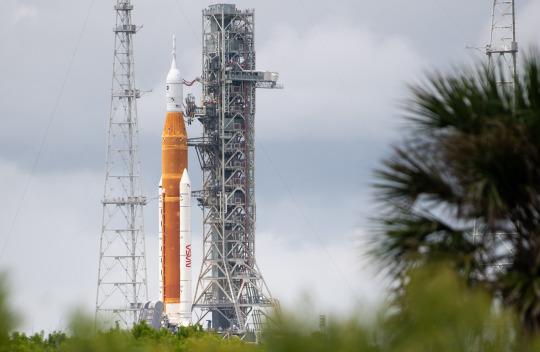
View On WordPress
0 notes
Text
NASA successfully completes vital Artemis 1 rocket fuel test
NASA successfully completes vital Artemis 1 rocket fuel test
The next Artemis 1 launch attempt might take place as soon as next week, seeing as NASA has met all the objectives it set out to do to consider its rocket’s fuel test a success. NASA had to test adding super-cooled fuel to the Space Launch System’s tanks to confirm the repairs it made after it scrubbed the mission’s second launch attempt in late August. The ground team at Kennedy Space Center…
View On WordPress
0 notes
Text
NASA’s Artemis-1 fuel test to decide moon rocket’s fate
NASA’s Artemis-1 fuel test to decide moon rocket’s fate
NASA encountered some trouble early in the day Wednesday as the space agency conducted a tanking test to determine if a fuel leak on the Artemis-1 rocket is fixed, which scrubbed the space agency’s most recent launch attempt earlier this month of the mega moon rocket from Kennedy Space Center in Florida.
The Space Launch System rocket with the uncrewed Orion spacecraft is slated to launch on…
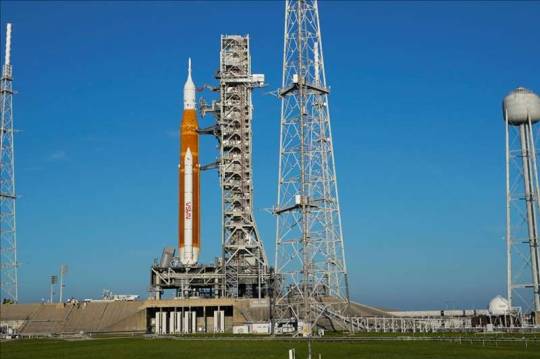
View On WordPress
0 notes
Text
NASA to replace faulty Artemis 1 hydrogen seal while rocket is still on launch pad
NASA to replace faulty Artemis 1 hydrogen seal while rocket is still on launch pad
NASA’s second attempt to launch the Artemis 1 mission had to be scrapped due to a hydrogen leak at the “quick disconnect” interface between the Space Launch System (SLS) rocket and the liquid hydrogen fuel feed line. The space agency will replace the faulty seal that caused the leak while the rocket is still on the launchpad.
During a post-scrubs press conference, James Free, Associate…
View On WordPress
0 notes
Text
NASA's Artemis 1 moon megarocket launch was just delayed
NASA’s Artemis 1 moon megarocket launch was just delayed
NASA’s former Space Shuttle manager saw this delay coming.
The space agency scrubbed the much anticipated first launch of its colossal new megarocket, the Space Launch System (SLS), on Monday morning, Aug. 29, due to a fueling problem with one of the rocket’s engines. Wayne Hale, who ran flights for the retired Shuttle, recently gave 50-50 odds for the launch happening on its initial try. The…
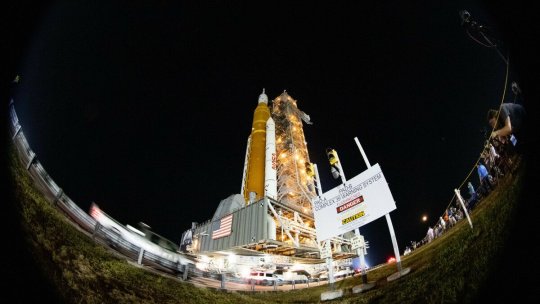
View On WordPress
0 notes
Text
Artemis moon rocket launch put back until 'late September' after leak forces second postponement
Artemis moon rocket launch put back until ‘late September’ after leak forces second postponement
NASA has called off the launch of its Artemis 1 rocket after a leak developed – the second time it has failed to go ahead – and has now said the next attempt won’t be likely until late September.
Engineers recommended to the launch director the planned lift-off should not go ahead.
The rocket’s launch, which was initially planned for earlier this week on Monday 29, was scrubbed following a…
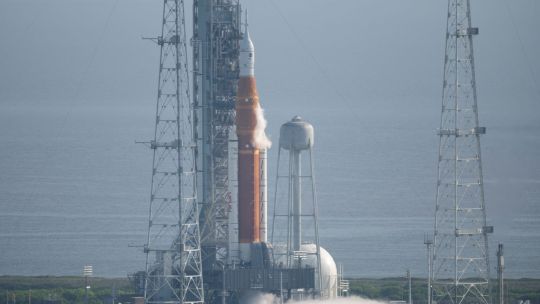
View On WordPress
0 notes